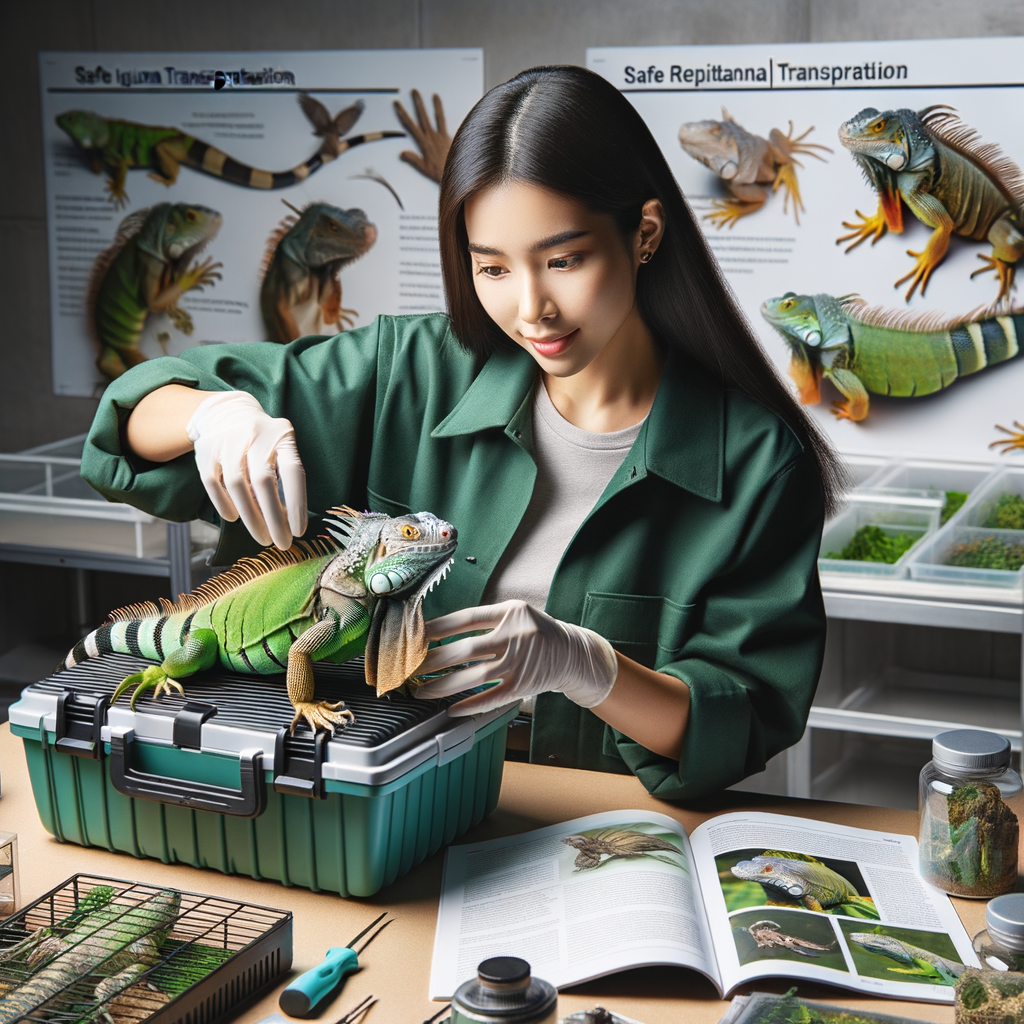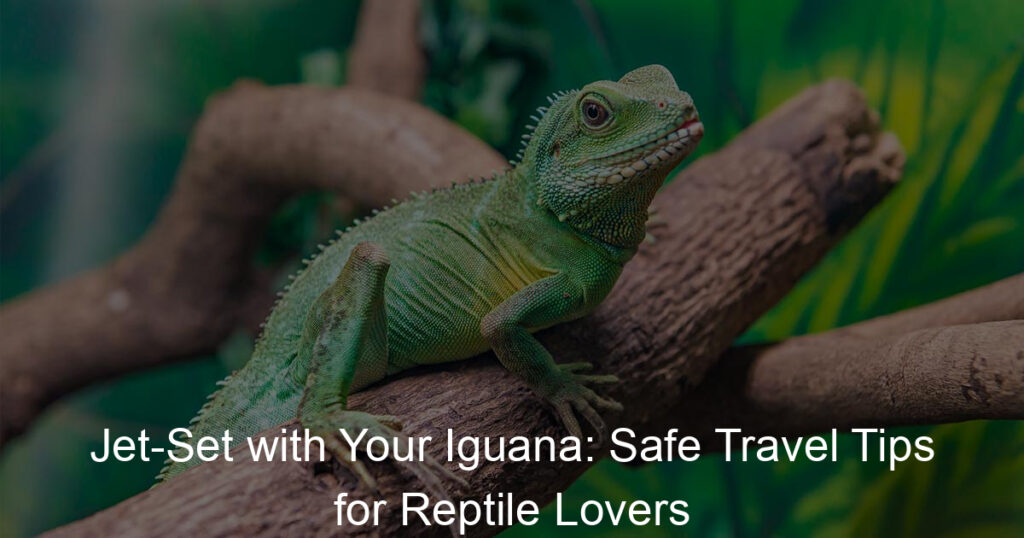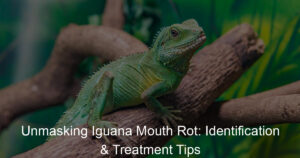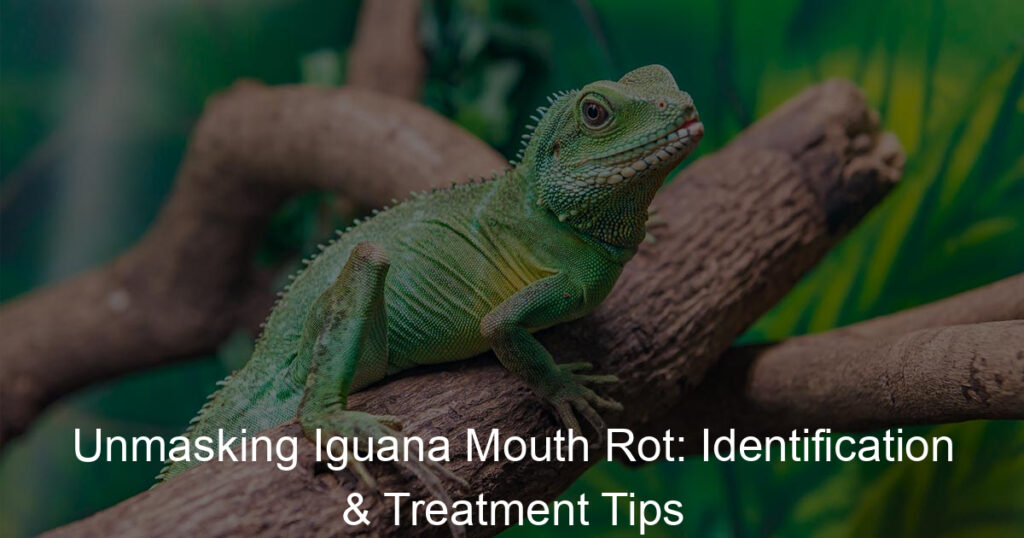
Introduction to Iguana Transportation
Transporting your pet iguana safely is a topic that many reptile owners find challenging. Whether you’re moving to a new home, going on a vacation, or taking your iguana to the vet, understanding the basics of iguana transportation is crucial. In this blog post, we will explore the need for safe iguana transportation and discuss some common challenges in reptile travel.
- Understanding the Need for Safe Iguana Transportation
- Common Challenges in Reptile Travel
Just like any other pet, iguanas also require special care and attention during travel. Iguanas are cold-blooded creatures, meaning their body temperature is influenced by their environment. Therefore, maintaining a comfortable temperature is crucial during transportation to prevent stress and potential health issues. Additionally, iguanas can become stressed in unfamiliar environments, so it’s important to create a comfortable and secure space for them during travel.
Traveling with reptiles, including iguanas, presents unique challenges. One of the most common issues is maintaining the right temperature and humidity levels. Iguanas require a specific range of temperature and humidity to stay healthy, which can be difficult to achieve during travel. Another challenge is ensuring the iguana is secure and cannot escape during transit. Iguanas are known for their climbing abilities, so a secure carrier is essential. Lastly, the stress of travel can affect an iguana’s eating and sleeping patterns, so monitoring their behavior before, during, and after travel is important.
In the following sections, we will delve deeper into how to prepare your iguana for travel, provide tips for safe transportation, and discuss post-travel care. Stay tuned to learn more about the fascinating world of iguana transportation.
Preparing Your Iguana for Travel
When it comes to traveling with your iguana, preparation is key. It’s not just about packing the right items, but also ensuring your pet is healthy and ready for the journey. Let’s delve into the crucial steps you need to take to prepare your iguana for travel.
Health Check
Before you embark on your trip, it’s essential to make sure your iguana is in good health. This involves two main steps:
- Visiting a vet before traveling with your iguana
- Ensuring your iguana is healthy and fit for travel
It’s always a good idea to schedule a visit to the vet before you travel. The vet can conduct a thorough health check to ensure your iguana is fit for the journey. They can also provide advice on how to keep your pet comfortable during travel, and may even recommend specific products or equipment to use.
After the vet visit, continue to monitor your iguana’s health. Look out for signs of stress or illness, such as changes in eating habits or behavior. Remember, a healthy iguana will handle travel much better than one that is not.
In conclusion, preparing your iguana for travel involves more than just packing the right items. It’s about ensuring your pet is healthy and ready for the journey. By following these steps, you can help ensure your iguana’s travel experience is as comfortable and stress-free as possible.
Packing Essentials
When preparing your iguana for travel, it’s important to consider the essentials that will ensure your pet’s comfort and safety. This includes creating a comfortable travel environment and packing all the necessary items your iguana will need.
-
Creating a Comfortable Travel Environment for Your Iguana
Your iguana’s comfort during travel is paramount. A stressed iguana can become ill, so it’s crucial to make the journey as comfortable as possible. Start by choosing a travel carrier that is spacious enough for your iguana to move around. It should also have proper ventilation to ensure your pet gets enough fresh air.
Line the carrier with soft towels or blankets to provide cushioning during the journey. Also, ensure the carrier is secure and won’t open accidentally. Finally, keep the carrier in a quiet and calm area of your vehicle to minimize stress for your iguana.
-
Essential Items to Pack for Your Iguana
When packing for your iguana, think about what your pet will need during the journey and once you reach your destination. Here are some essentials to include:
- Food and Water: Pack enough food and water for the journey and a few extra days. Include a water dish that can be secured inside the carrier.
- Heat Source: Iguanas need warmth, so pack a portable heat source like a heat pad or lamp.
- First Aid Kit: Include a basic first aid kit with items like tweezers, antiseptic wipes, and bandages in case of minor injuries.
- Comfort Items: If your iguana has a favorite blanket or toy, bring it along to help soothe your pet during the journey.
Remember, every iguana is unique, so adjust this list based on your pet’s specific needs and preferences.
Safely Moving Iguanas: Reptile Travel Tips
Transporting your iguana safely is crucial for their well-being. Particularly when traveling by car, there are two key factors to consider: securing your iguana’s enclosure and maintaining optimal temperature and humidity. Let’s delve into these important aspects.
Traveling by Car
- Securing Your Iguana’s Enclosure in the Vehicle
- Maintaining Optimal Temperature and Humidity
Ensuring your iguana’s enclosure is secure in your vehicle is the first step to a safe journey. An unsecured enclosure can move or topple over during transit, causing stress and potential injury to your iguana.
Use seat belts or specially designed pet carrier straps to secure the enclosure. Make sure it’s stable before you start driving. It’s also advisable to place the enclosure in a spot where it won’t be directly hit by sunlight, as this can cause overheating.
Iguanas are cold-blooded animals, which means they rely on their environment to regulate their body temperature. It’s essential to maintain an optimal temperature within the enclosure during travel.
The ideal temperature for an iguana is between 80 and 85 degrees Fahrenheit during the day. You can use a portable reptile heater or a heated mat to maintain this temperature in the car. Remember to also provide a cooler area in the enclosure where your iguana can retreat if they feel too warm.
Humidity is equally important for iguanas. They thrive in a humidity level of 70-80%. A portable humidifier can help maintain this level in the enclosure. Alternatively, you can mist the enclosure with water regularly.
In conclusion, when traveling by car with your iguana, it’s essential to secure their enclosure and maintain the right temperature and humidity levels. These steps will help ensure your iguana’s comfort and safety during the journey.
Traveling by Air
When it comes to transporting your beloved iguana by air, there are two key areas you need to focus on. These include understanding the airline’s policies for transporting reptiles and preparing your iguana for the journey. Let’s explore these topics in more detail.
- Understanding Airline Policies for Transporting Reptiles Safely
Not all airlines allow reptiles on board, and those that do often have specific rules and regulations. These policies are designed to ensure the safety and well-being of your pet during the flight. It’s crucial to research and understand these policies before booking your flight.
Some airlines require reptiles to be transported in the cargo hold, while others may allow them in the cabin if they are in a secure, ventilated carrier. Additionally, some airlines have temperature restrictions, only allowing reptiles to travel when the temperature at both the departure and arrival airports is within a certain range.
Remember, these policies can vary greatly between airlines, so it’s essential to contact your chosen airline directly to get the most accurate information.
- Preparing Your Iguana for Air Travel
Preparing your iguana for air travel is just as important as understanding the airline’s policies. Here are some tips to help your pet have a safe and comfortable journey:
- Acclimate your iguana to its travel carrier: Start by placing your iguana in its carrier for short periods of time, gradually increasing the duration. This will help your pet become familiar with the carrier and reduce stress during the flight.
- Ensure proper temperature and humidity: Iguanas need a specific temperature and humidity range to stay healthy. Consider purchasing a portable reptile heater and a hygrometer to monitor these conditions during the journey.
- Provide water and food: Iguanas can become dehydrated during travel, so it’s important to provide a water dish in the carrier. Also, feed your iguana a few hours before the flight to prevent hunger.
Traveling by air with your iguana can be a smooth experience if you take the time to understand the airline’s policies and prepare your pet properly. Remember, the safety and comfort of your iguana should always be your top priority.
Iguana Travel Guide: Long Distance Journeys
Overnight Stays
When embarking on long-distance journeys with your iguana, overnight stays are a crucial aspect to consider. It’s important to ensure your pet’s comfort and safety during these stops. Here are some key points to remember:
- Finding Reptile-Friendly Accommodations
- Setting Up a Temporary Habitat for Your Iguana
Not all accommodations are suitable or welcoming for reptiles. Therefore, it’s essential to research and find places that are reptile-friendly. Some hotels and motels have specific policies for pet reptiles. You can call ahead or check their websites to confirm. Remember, your iguana’s comfort should be a priority.
Once you’ve found a suitable place to stay, the next step is setting up a temporary habitat for your iguana. This should mimic their home environment as closely as possible. A portable reptile cage or tank can be useful for this. Ensure it has a heat source, as iguanas need warmth. Also, include familiar items like their favorite basking spot or toy. This will help your iguana feel more at home, reducing stress.
Traveling with your iguana can be a rewarding experience if done right. Ensuring comfortable overnight stays is a significant part of this process. Remember, a happy iguana is a healthy iguana!
Feeding and Hydration
When traveling with your iguana, it’s essential to ensure they receive proper nutrition and hydration. Let’s explore how to feed your iguana during travel and keep them hydrated.
-
Feeding Your Iguana During Travel
Feeding your iguana while on the move can be a challenge. However, it’s crucial to maintain their regular feeding schedule as much as possible. Iguanas typically eat a diet of fresh fruits, vegetables, and greens. Pack a cooler with pre-cut food items and feed your iguana at their usual feeding times. Remember, it’s better to offer smaller meals more frequently during travel to prevent digestive issues.
-
Ensuring Your Iguana Stays Hydrated
Hydration is equally important for your iguana’s health, especially during travel. Iguanas get most of their water from the food they eat, but they also need fresh water available at all times. Carry a portable, spill-proof water dish and offer water to your iguana regularly. You can also mist your iguana with water to help them stay hydrated. However, avoid soaking them as this can lead to hypothermia in cooler climates.
| Tip | Description |
|---|---|
| Regular Feeding Schedule | Try to maintain your iguana’s regular feeding schedule during travel. |
| Pre-cut Food Items | Pack a cooler with pre-cut fruits, vegetables, and greens. |
| Small Frequent Meals | Offer smaller meals more frequently to prevent digestive issues. |
| Fresh Water | Always have fresh water available and offer it to your iguana regularly. |
| Misting | Mist your iguana with water to help them stay hydrated, but avoid soaking them. |
Reptile Owners Travel Advice: Post-Travel Care
Travel can be stressful for your iguana. It’s essential to monitor their health and behavior closely after a trip. Here’s what you need to know:
Monitoring Your Iguana
After a journey, your iguana may behave differently. It’s crucial to keep a close eye on them to ensure they’re healthy and comfortable. Here are some steps to follow:
- Checking your iguana’s health post-travel
- Signs of stress or illness to look out for
Once you’ve arrived at your destination, give your iguana a thorough check-up. Look for signs of physical stress, such as changes in skin color or texture, loss of appetite, or unusual behavior. If you notice anything out of the ordinary, it might be a good idea to consult a vet.
Stress in iguanas can manifest in various ways. Some common signs include reduced activity, loss of appetite, and changes in stool. More severe signs could be rapid weight loss, aggression, or even self-harm. If you notice any of these signs, seek professional help immediately.
Remember, the key to a healthy iguana post-travel is careful observation and prompt action. If you’re attentive to your pet’s needs, they’ll be back to their usual self in no time.
Returning to Routine
Once your iguana has safely returned from travel, it’s crucial to help them readjust to their regular routine. This process involves two main steps: helping your iguana readjust after travel and resuming regular feeding and care routines.
-
Helping Your Iguana Readjust After Travel
Travel can be stressful for iguanas, and they may need some time to readjust to their home environment. Start by giving your iguana some quiet time in their familiar habitat. This will help them feel safe and secure. You can also try to recreate their natural habitat as closely as possible, using plants, rocks, and other items they are used to.
It’s also important to monitor your iguana’s behavior closely during this readjustment period. Look for signs of stress, such as loss of appetite or changes in behavior. If you notice any concerning signs, consult with a vet immediately.
-
Resuming Regular Feeding and Care Routines
Once your iguana has had some time to readjust, you can start to resume their regular feeding and care routines. This includes providing fresh food and water, cleaning their habitat, and providing them with opportunities for exercise and socialization.
Remember, consistency is key when it comes to caring for an iguana. Try to stick to the same feeding and care schedule every day. This will help your iguana feel secure and reduce stress.
Resuming regular routines also includes monitoring your iguana’s health. Regular health checks can help you spot any potential issues early and ensure your iguana stays healthy and happy.
Conclusion: Iguana Travel Safety
As we conclude our comprehensive guide on iguana travel safety, it’s essential to revisit the critical points we’ve discussed. The safety and wellbeing of your iguana during travel relies heavily on your preparation and the care you provide.
- Recap of tips for moving iguanas safely: We’ve covered various tips to ensure your iguana’s safe travel. These include acclimating your iguana to its travel enclosure before the journey, maintaining the right temperature and humidity levels, and providing adequate hydration and nutrition. Remember, a calm and comfortable iguana is a safe iguana during travel.
- Importance of preparation and care in reptile transportation: Preparation is key in ensuring a smooth journey for your iguana. This includes researching and understanding your iguana’s needs, preparing the travel enclosure, and planning the travel route. Post-travel care is equally important to help your iguana adjust to its new environment. Regular health checks and monitoring are crucial to detect any signs of stress or illness early.
Traveling with an iguana may seem daunting, but with the right preparation and care, it can be a stress-free experience for both you and your reptile companion. Remember, the safety of your iguana is paramount, and your efforts can make a significant difference in ensuring a safe and comfortable journey.
By following the advice and tips in this guide, you can confidently embark on your journey with your iguana, knowing you’ve done everything possible to ensure its safety and wellbeing.













